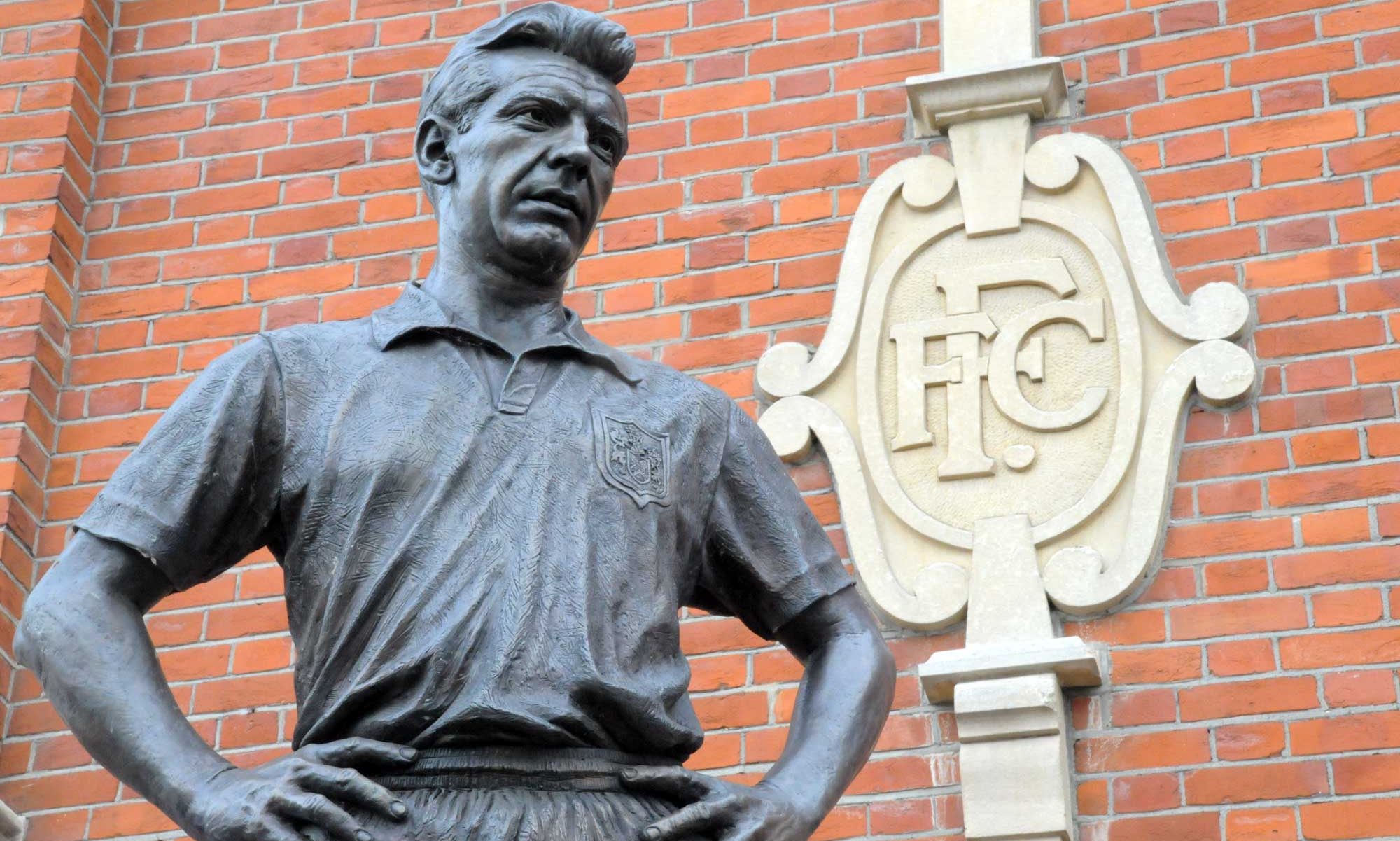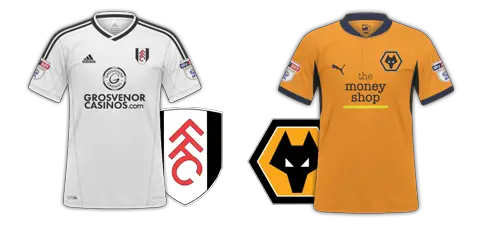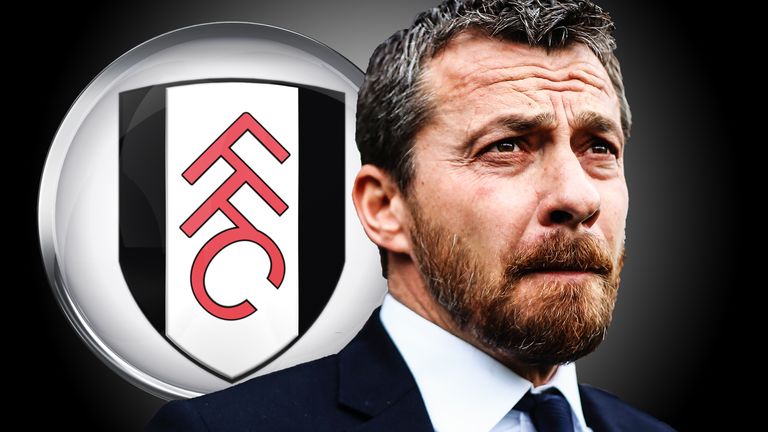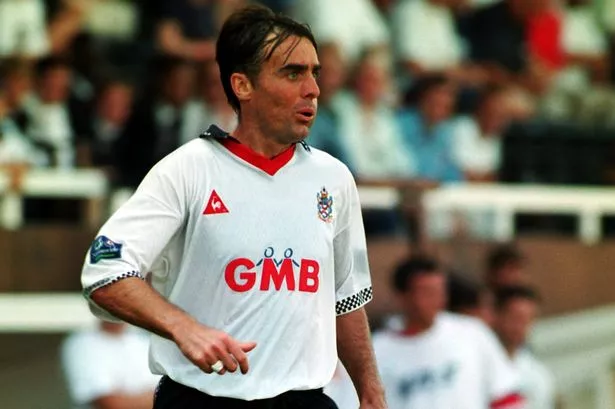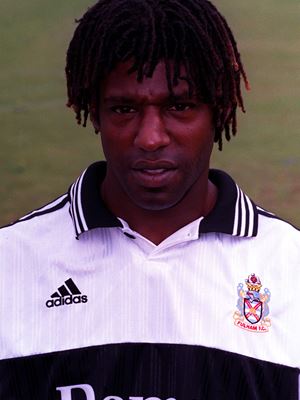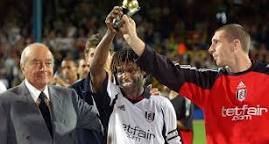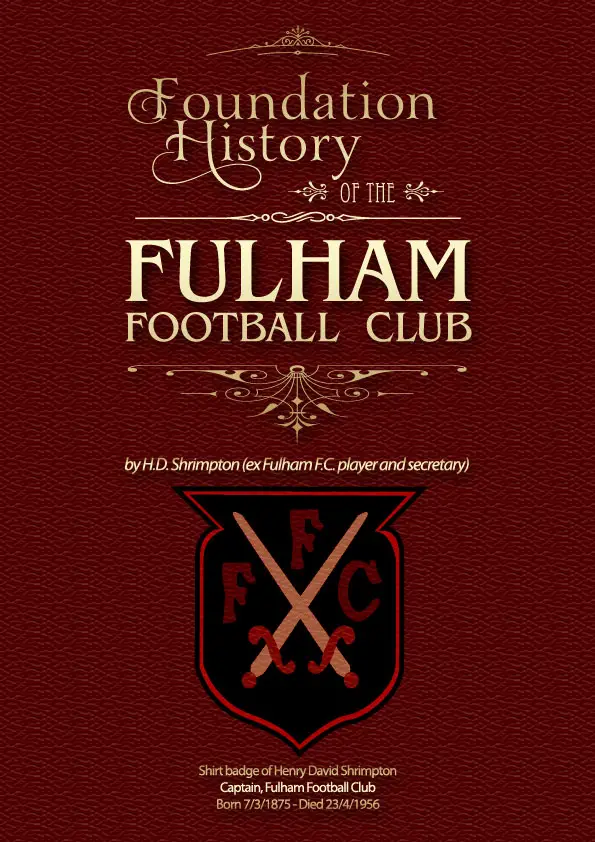
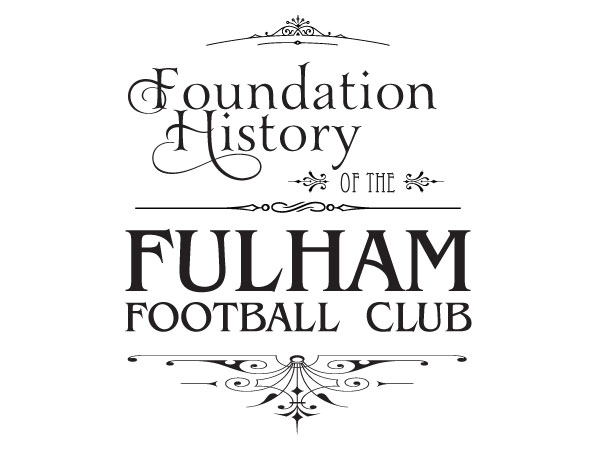
“Foundation History of The Fulham Football Club”
by H.D. Shrimpton (ex Fulham F.C. player and secretary)

LBNo11
During the 1969-70 season Fulham FC published in it’s programme a serialisation of a booklet from a former player and club secretary Mr H.D.Shrimpton entitled “Foundation History of Fulham Football Club”. The first part appeared on December 27th 1969 for the game against Barrow. The editor added this postscript to the serialisation:-
“Mr. E.W. Alexander, who lives in Birmingham yet supports Fulham with an inspiring tenacity, has sent us a copy of a booklet he bought recently. We found it fascinating. It is a great opportunity to set the record right on a number of things, so we will be reproducing parts of it from time to time.
We are not sure of the date but assume it is from before the first (world) war.”
In the spring of 1997 the same booklet was re-published for £1.00 to help with the funding of Fulham 2000 campaign.
I have always wanted to have such an important historical document available for a wider audience and with the advent of the cyber age this is now possible. I managed to trace (thanks to Geoffrey the cabbie on the official message board, and Jenny Gower at Fulham FC) Henry Shrimpton’s grandson, the former Fulham FC director David Shrimpton, whose family still support Fulham, and he very kindly gave me permission to reproduce the booklet exclusively for Friends Of Fulham, TOOFIF and Fulham USA. It must be noted that the writing is in the vernacular of that period, and that although at times the information appears disjointed it is nonetheless enthusiastic and interesting. I have deliberately not changed the wording of the publication in any way, and have left the original programme editors notes from 1970 in italics.
In the original accompanying notes with the series, there was a foreword from G.H.T Shrimpton, CBE., TD. The father of David Shrimpton. “My father published the booklet in 1950 and it is pleasant to learn there is still interest in his account of the origins of the club. My family still takes some pride in its association with Fulham. The record of four brothers playing for it, three of them regularly, seems unlikely to be equalled and is enhanced by the fact that one of them, Tom Shrimpton, captained the first Fulham team to play at Craven Cottage. My father and brother were in the side.
When his employers required my father to reduce his commitment to football, he turned out for Fulham under the name of S.D. Henry. However he was always known locally as ‘Mo’, a name he acquired as a young full back for Fulham against Dartford in an away Cup tie. Fulham who were not expected to win, took a 1 – 0 lead in the second half and thereafter my father put so many clearances in the river that the name of the boatman who was called each time to retrieve it remained with my father until he died in 1956, aged 81.
I was weaned on Fulham football and although I played rugby football for Kent and London Counties and was for fifteen years chairman of the Old Blues R.F.C., I used to return with my father to Craven Cottage when I was injured or the ground too hard for rugby.
Now my early conditioning has re-asserted itself. My sons, fourth generation Fulham supporters, and I rarely miss a first or reserves game there”
David Shrimpton has written a further postscript to accompany this ‘electronic’ serialisation.
“The family connection with Fulham is a genetic defect, but this applies to many long-standing Fulham supporters!
Our family involvement in Fulham goes through four generations. My grandfather, Henry, captained Fulham and claimed to be the first person to kick a football at Craven Cottage when on 10th October 1896 he led the team out to play Minerva, the opening game at the new ground.
Three of his brothers also played for Fulham; he then became Company Secretary, and the registered office of the Club was at the family home in Fulham, so he was well qualified to write the ‘Foundation History of Fulham Football Club’.
My father, George Shrimpton, was a life long supporter and a Vice President, and he and his father took me to my first match in 1949. I became a Director of the Club in 1991, worked with the Muddyman family to rescue the Club, developed the Dream Scheme to find someone seriously rich to take over the Club (instead of the terminal plan to reduce capacity down to 12,000 by building flats on three sides of the ground) and through an unplanned act of fate was responsible for introducing MAF to Fulham – and the rest is history”.
Fulham FC began it’s life 130 years ago this year (2009), and so to commemorate this – we bring you:-
Part I

The Fulham Club was founded in 1879 – not 1880 as sometimes published. In its very varied existence it has been faced by many set-backs but has invariably come out on top.
The Club today boasts a neat, compact and comfortable ground on the banks of the Thames at Craven Cottage, and a very loyal and ardent array of followers who, win or lose, continue to give their unstinted support while good, clean honest to goodness football is played.
The real founders of the club were the Rev. Cardwell of St, Andrew’s, Fulham and the Rev. P.S.G. Propert (later Prebendary) of St. Augustine’s Mission, Lillie Road.
The latter in his earlier days at Oxford had been a footballer and a general all-round athlete, but he never played for the club. These two clergymen in their spare time fostered sport among the youngsters of St. Andrews Youth Club.
Football and cricket were their main sports, the cricket section being coached by Mr. W.H. Patterson, one-time captain of Kent County Cricket Club. The football club was known as St. Andrews.
Its ground – not enclosed – was situated in Star Road, Fulham, adjacent to the school, and was commonly known as “The Mud Pond.”
Although it has been stated from time to time that Fulham F.C. started their career at Lillie Road, this is not correct, for one goal backed on to Star Road School wall and, moreover, Lillie Road School was not built until 1893.
The first secretary of the club was Mr.Tom Norman. Playing colours were at first nondescript, but when the club began to get into its stride, definite colours were decided on, these being light and dark blue quartered jerseys, later changed to shirts in keeping with the then prevailing patterns.”
Part II
The goalposts at this time (1893) consisted of two uprights with tape across to act as the crossbar. Although the main basis of the game, the rules and the number of players were the same as today, football was then a very simple sporting affair compared with the vast business organisation, governed by finance, that operates today.
The football enthusiast had to make do with such waste ground as might be available. In the case of the ‘Mud Pond’ the playing area was only some 85 x 65 yards compared with today’s minimum 100 x 80 yards (Editors note: this was written before the First World War. The dimensions in 1970 are – not more than 130 yards or less than 100 in length and not more than 100 yards or less than 50 yards in breadth).
There were no stands, no ‘gates’ financially and literally. If as many as an odd hundred or so turned up to watch, it was considered quite an occasion.
The spectators stood right up to the touchlines, in fact they made the lines, as there was no marking out with whitewash by a mechanical contrivance that looks like a lawnmower, as is neatly and efficiently done today. There were no nets behind the goals. Usually the playing time was half an hour each way – or possibly forty minutes if all concerned had energy enough left. This is easily understood because there was no training, coaching, tactics, elaborate tackling or the other trappings of professionalism. The men played football for the simple and very good reason that they liked football.
They played it when and where they could in spare time, usually Saturday afternoons, for no other reason than that they enjoyed it. They turned out in what clothes they could lay their hands on at the moment; some wore caps, some played in long trousers and some wore knickerbockers.
The game itself might be described as a rough and tumble sport with lots of mud, almost no holds barred, plenty of hefty tackling and shoulder charging. There were two umpires, one in each half of the field. Perhaps after all, ‘those were the days.’ Special football boots were not worn by players in the class of the St. Andrew’s Club at this period. Usually any old boots served the purpose, but to avoid slipping, bars of leather were nailed across the soles and the heels.
Studs were not brought into use until after pukka football boots were generally adopted. Then several members of the Club had their boots made to measure by a local bootmaker for 12s. per pair. (2)
In the early days there was no such luxury as a dressing room. The players donned their kit at home and shed their outer gear on the ground to be taken care of by friends manning the touchline. After the game the players dragged their weary way homewards – typical ‘muddy oafs’. Washing accommodation too was of limited character. Even for a few years after the migration to Craven Cottage the sole provision consisted of family-type zinc bowls placed on a bench outside the dressing room. Stripped to the waist, players found it far from pleasant scraping the grime off in bitter wintry weather.
Part III
After a few years of existence the club found private accommodation at the old Ranelagh Club, under Putney Bridge Railway arch, where the present Ranelagh Gardens are situated. The dressing rooms were at the ‘Eight Bells’, (3) Fulham High Street, and the Club name was changed from Fulham St. Andrew’s to avoid confusion with other London clubs called simply St. Andrew’s.
Jack Howland a big, jovial fellow of some two hundred pounds or so-was the skipper of the team. When the Putney Bridge ground was required for building purposes, the Club became more or less a wandering side. For two years it fought out its matches on Eelbrook Common, Putney Lower Common and Roskell’s field situated in Parsons Green Lane. During games on the last named site players had to keep their eyes skinned as a tree stood in magnificent isolation in one corner of the pitch.
It has been stated in other accounts of the Clubs history that it rented a ground from Captain James in Halford Road. This is entirely erroneous. That ground was once occupied by Stanley F.C. – strong opponents of Fulham F.C. in all competitive football.
Eventually the club migrated to Barn Elms, Ranelagh, Barnes. Dressing accommodation was at the ‘Red Lion’ public house, Castelnau. (At the time it was the usual practice for clubs not boasting accommodation of their own to change in public houses.) It was on the Barn Elms ground that wooden crossbars for the goals were first used.
While playing at the Barnes the Club had a fair run of success, and by now had got together a loyal band of supporters. Among these was Mr. Teddy Fox, well-known local sportsman who was, very conveniently, mine host at the ‘Half Moon’ public house, Putney. Incidentally this hostelry was opposite to the playing ground. Fox, by his great enthusiasm and kindly interest in the Club, was instrumental in the move is seasons 1889-90 to the ‘Half Moon’ ground behind the boathouses at Putney.
At this time, the number of supporters began rapidly to increase, mustering in hundreds. The most enthusiastic followers and supporters displayed a card stuck in the bands of their bowlers or pinned on their caps bearing the legend ‘PLAY UP FULHAM’. The presence of ladies at matches was quite a rare sight. Perhaps one or two girlfriends of players would put in an appearance. As time went on however, the number of the fair sex attending games rapidly increased, and this eventually called forth the comment in the Press that ‘ladies again graced the match’.
At the present day it is common to see a large feminine attendance, and the Fulham Supporters’ Club testifies to the great appeal the game now has for the ladies by the large number on its membership roll. It is interesting to recall that in 1894 a ladies’ football club was formed in North London and played on the ground of Crouch End F.C.
Returning to the ‘Half Moon’ ground, this consisted of two pitches and was shared with the famous ‘Wasps’ Rugby Football Club. This was the period of the special charity matches usually played on a Easter Monday, and called ‘Top Hat’ and ‘Bonnet’. For these occasions one side turned out in top hats and working clothes and the other in bonnets and skirts, presumably borrowed from their wives and sweethearts. Whether the bonnets and skirts were ever returned to their rightful owners the records do not show.
Charges for admission to games were not instituted until the ‘Half Moon’ ground was tenanted, when the nominal sum of three pence (4) was the amount demanded. With the advent of the Craven Cottage ground, the admission charge was raised to sixpence. With an extra three pence for the enclosure.
Part IV

By 1890 the Club was beginning to force itself into the public eye, so much so that Press notices were given. The colours were again changed, becoming one-inch black and white vertical striped shirt with blue knickers. (5) Under the able secretaryship of Mr. Arthur Newport, an ex-student of St Marks College, the dark side, and a master at Halford Road School, who assisted the team at centre-half, the club started about the business of becoming a premier club of London.
The name of Fulham St Andrew’s was dropped. And the club became Fulham F.C.
It was on the ‘Half Moon’ ground also that the goal nets were used for the first time. Fulham became holders (1890) of the ‘West London Observer’ Football Challenge Cup – a beautiful trophy put up for local competition by the proprietors of the paper. The final result was a win against Stanley F.C. by five goals to two. Each member of the winning team received a souvenir medal of very handsome design.
Season 1892 saw Fulham take another upward step when they entered for the London Senior and Middlesex Senior Cups, but, although playing with conspicuous success, they failed to win another competition. This season saw the West London League formed, its members being Fulham, West End, Kildare, Queens Park Rangers, Stanley, Grove House, Paddington, Hounslow, Southall and St. Johns College.
At Easter Fulham embarked on their first tour of the West Country. The first game – against Weymouth – resulted in a goalless draw. The second game was a big test as the opponents were the Dorset representative team. Although Fulham put up a good fight they lost by two goals to one. However, they wound up the tour in triumphant style when they defeated Yeovil by three goals to one. A special item of interest in the game was the grand play at back of the Rev. Horsham of Yeovil.
During this season Fulham became champions of the West London League – certainly a praiseworthy feat when one remembers the opposition they were called upon to meet. J. May who played some wonderful games in goal, was at this time skipper of the team. Other members being T. Shrimpton, The Rev. G.M.Hall (an Old Blue of St. John’s Church, Walham Green), Pearce, Jackson, Blight, Wilkins, Draper, Sermon, King and Carter.
In 1893 Fulham again gave a good account of themselves without winning either of the cups for which they entered. In the London Senior Competition they disposed of Caledonian Athletic (now London Caledonians of the Isthmian League), but their career in this competition was cut short when they met the Royal Ordnance Factories F.C. (now the famous Arsenal F.C.) and lost by the odd goal.
It was during this season that the controversy arose with reference to a Fulham player named Payne who was alleged to have been lured away to play for the Spurs for the consideration of a pair of football boots.
Quite recently a London weekly sports paper published a picture of Ernie Payne stating that he was the first professional footballer and was loaned to Fulham by the Spurs. Both these statements are incorrect, for Payne, though suspended for a month, never became a professional and far from being the first ‘pro’, his playing days were some twenty years after the general adoption of professional football. Furthermore he was not loaned to Fulham, but was ‘poached’ by the Spurs from Fulham. It was also stated recently in the London daily press that this case resulted in both the Spurs and Fulham becoming professional.
Actually only Tottenham turned professional. Fulham, it was seen, did not take this step until later in season 1900-01.
Part V
After the period at the ‘Half Moon’ ground, the next important move by Fulham was to Craven Cottage in 1896. The colours were again changed, this time to shirts with red bodies, white sleeves and collars as now worn by Arsenal F.C. At this time the Craven Cottage house and ground were in a very dilapidated state (*), the grounds were all ups and downs, covered with uncared-for trees and shrubs, and dotted with lakes and mud left by high tide floods.
Members of the committee and supporters all put their shoulders to the wheel, and everyone concerned showed great enthusiasm and keenness in efforts to assure a really good home for the club. Harold Wilkins – also a master at Halford Road School – was the secretary, and this player of earlier days had a great hand in developing the Club. The following is an extract from a local paper of September 12th; 1896:
‘ But while the Stanley F.C. are seeking fresh fields and pastures new, the Fulham Football Club have been making extensive arrangements in order to meet the requirements of the sporting section of the community. Their efforts in providing such a magnificent ground as that which is now being prepared at Craven Cottage, Crabtree Lane, deserves to meet with extensive patronage. The new ground, which will be ready for opening in about three weeks time, is in the form of a vast amphitheatre, and is capable of accommodating some 20,000 persons; it is in fact, almost a replica of the famous arena at Crystal Palace.
No expense has been spared by the committee who are now considering plans for the erection of a grandstand and pavilion. A track is to be prepared outside the turf, and its possibilities will be about four laps to the mile. The club hopes to make the ground a centre of athletic sports generally. It is a boon, the need of which has been long and sorely felt in Fulham. The Club this season has entered for the English Cup, London League, London and Middlesex Senior Cups, besides having arranged a capital programme of what may be called private fixtures.
The fact that the organisation has become possessed of the new ground has already given it a splendid impetus in its favour, for 40 new members have joined since the commencement of the year, bringing its total to about 250. Mr Hayes Fisher, M.P. for Fulham, is the patron, and Mt. T.W. Shrimpton, the captain.’
Mr. Arthur Thomas, the honorary treasurer, and Mr. Arthur Wilson, a member of the committee, also put in splendid work for the Club at the time. The circumstances in which the Craven Cottage ground was obtained were these: it was the property of the Ecclesiastical Commissioners and leased to Mr. Tod Heatley. From the latter, Fulham F.C. obtained tenancy on the ‘half gate’ principle, that is to say, half of the gate money was paid to the landlord as rent. In after years, other possession arrangements were made.
On obtaining the ground the then Fulham committee found themselves faced with the task of filling in the creek which led from the Thames, and felling the vast number of trees on the estate. This work was done by contract, and a local firm was given the job of raising the ground some six feet above the high water level and completing it as a playing pitch with a Cumberland turf surface.
The dressing rooms, which comprised substantial wooden buildings, were made and erected by members of the committee and honorary members in their spare time, supervised by Mr Harry Coleman, also an old player and committee man. There were two team dressing rooms and one for officials, in addition to a members’ room with fully licensed canteen.
Part VI

The Spectators’ bank was first raised by road sweepings supplied by the Fulham Borough Council, who paid the Club a “shooting” fee per load. The contractor was at this time removing material from the Shepherd’s Bush Bank Tube working, from where it was dumped at Craven Cottage to meet the required level and to complete the slopes.
The playing pitch was near completion when difference of opinion arose between Club and the contractors resulting in legal proceedings. To meet the expenses of these, a public meeting of the Clubs’ supporters was held and the money guaranteed by various friends.
One outstanding contributor was the late Mr. W. Pullen of the Richmond Hotel, West Brompton, who generously lent £120 free of interest: the Club won it’s case, and another meeting was convened to return the various sums of money to the many subscribers. This took place at the Richmond Hotel, when an illuminated address was presented to Mr. Pullen for his great kindness in lending the said sum.
The first game on the new ground was Fulham Reserves versus St. Mary’s Recreation. The match was well supported, and the Fulham Reserves won a very close game by the odd goal. The Club had a successful season in the newly-formed London League and the gates of between 4,000 and 5,000 were quite a common thing at First Team games.
The following is the side that represented the Club in many of their Cup and League fixtures in their first season at the Cottage: J. May; T.W. Shrimpton, H. Shrimpton; Pearce, Jackson, Churchill; J. Shrimpton, Witheridge, Bennett, Grimmond and Robertson. It will be seen that there were no fewer than three Shrimpton brothers in this eleven, while Jim Shrimpton, who was captain of the Swan Brewery Club (commonly known as “The Bungs”) assisted the Club on many occasions. Subject to any other claims, for four brothers to turn out for one team seems to be a record.
It may be another record that each of these four brothers served as the Club’s secretary during their membership, and the elder brother, Tom was captain of the Club for many years.
There were many “Bands of Brothers” who did yeoman service for the Club before professionalism was adopted, but more of that later.
When the club gave up the tenancy of the Ranelagh Club’s old ground at Putney Bridge, dissension arose among the members, and several of the First Eleven threw in their hands and formed a new club under the name of “Colton F.C” with headquarters at the “Colton Arms”, West Fulham; but this club had a very short existence.
The members who did stick to the old colours were principally second team players. They continued to carry the Club’s programme and re-organise themselves to suit the circumstances. The club then had no regular or settled playing pitch or accommodation, and prior to going to Barn Elms, the committee made their headquarters in Haldane Road at the home of the Shrimpton brothers, and thus it remained for a number of years.
Part VII
Here it would seem proper to set down some particulars of the original Craven Cottage. The Cottage was far from being the humble abode the name would suggest. Indeed, it was a superb but perhaps a little pretentious residence full of historical interest, and stood in magnificent grounds.
For some years before the destruction by fire in 1888, the house and estate were under the care of Mr. Emmett, an ex-policeman of Walham Green, and while he was on holiday, the house met it’s doom by fire and the shell only of this once splendid residence remained. As bad luck would have it, the house was not insured. Following 1888 and during the time that Billy Reader of Fulham was the 9-stone Champion of the World, the site became the scene of many prize fights.
Built in 1780 by William, 6th Baron Craven, Craven Cottage was owned by various persons until 1834; when it was purchased by Charles King, a famous money-lender known among his associates and society of the time as “Jew King.” During King’s ownership of Craven Cottage it became a popular resort for the world of fashion.
In 1839, the Cottage became the house of Edward Earle Bulwer-Lytton (Lord Lytton), the distinguished novelist, orator and statesman, and it was here he composed several of his famous works, including “Night and Morning”, “The Last of the Barons” and “The New Simon”. It is said that he also wrote “The Last Days of Pompeii” at the Cottage.
In 1846 Sir Ralph Howard became the owner, and Craven Cottage continued to be the rendezvous of high society. Included among it’s many visitors and guests were the Prince of Wales (Edward VII), the French Emperor and Empress, Prince Louis Napoleon, Sheridan, Disraeli, etc.
In 1868, W. Bentley Woodbury, an American, took Craven Cottage for conversion into a pleasure resort, but the experiment failed. Mr. Tod Heatley eventually purchased the property, and from 1872 the estate was tenantless until May8th, 1888 when the Cottage, as already stated, was entirely destroyed by fire.
North of Craven Cottage was another famous mansion and estate named Rosebank, and between Rosebank and Craven Cottage, adjoining the latter, was the establishment called Rowberry Mead with its famous osier beds owned by the Waldrens, a very old Fulham family. The osiers were cut and dried and used in the Waldrens’ basket-making industry in Fulham.
Opposite the Cottage, on the east side of the estate, was situated Millshot Farm, owned by William Bagley, a descendant of one of the oldest Fulham families.
Lord Lytton, during his tenancy of the Cottage, paid the Bagley family £50 a year for the right of a private road through the Farm, from his house to Fulham Palace Road.
Part VIII
At the south end of the Cottage grounds were the famous Craven Steps. These Steps were at the end of an elevated terrace and concrete wall which ran the full length of the grounds along the riverside. An inlet from the Thames ran into the estate at the extreme south end adjoining the Steps.
On each side of this inlet were rows of beautiful old trees with tremendous trunks. The Craven Steps and concrete wall became famous as landmarks for the ‘Varsity and other famous boat races. The concrete wall was to prevent flooding of the estate from high tides, but in spite of this precaution there were time when the grounds became a vast lake. According to some accounts the purpose of the inlet was to enable visitors to draw close into the house in their State barges at high tides.
Adjoining Craven Cottage at the south end beyond the said inlet was the meadow named “Palesmead” which extended to Bishop’s Palace drive. This meadow was afterwards known as “Fielders Piece” and leased by a butcher of this name whose business was in High Street, Fulham, and who used the meadow for cattle grazing.
“Fielders Piece” was the home of the Old Sherbrookians F.C. just prior to Fulham F.C.’s occupation of the Cottage.
There was no Stevenage Road when Craven Cottage became a football ground. From Crabtree Lane, passing between Millshot Farm and the Cottage, was just a cart-wagon track and continuing on from the south end of the latter to Bishop’s Avenue, alongside “Fielders Piece,” was a narrow footpath bordered by beautiful elm trees said to be 200 years old.
It is thought that when the Club took over the estate the house was used as it’s first pavilion, but the decayed remains of the once palatial residence were demolished when the making up of the playing pitch was commenced.
While the estate was derelict, it became the habit of youngsters to bathe from the Steps (boys being what they are) and several learned to swim at this spot. Also many youngsters unfortunately lost their lives. One particular lad, unable to swim, fell into the river at high tide, and a Halford Road schoolboy named Harry Cane, who happened to be playing in a school representative match, heard his cry for help. Rushing across the pitch, Cane dived in and rescued the child. Then he changed his wet clothes and finished the game.
This incident at Craven Steps occurred in Fulham’s early tenancy, Cane, in after years signed for Chelsea F.C.
A peculiarity about the Cottage was that the house had a room with eight doors leading to different parts of the mansion. During the course of laying out the ground a subterranean passage was unearthed which led under the river towards Barnes, and rumour has it that it was used as a convenient way of giving any undesirable person the slip – probably a “get-away” for political reasons.
Also during the work of converting the grounds, a workman suddenly disappeared from view and was found unhurt at the bottom of an old 12 foot well. In excavating he had fallen through the rotten cover of the well no one was aware of.
Part IX
I now pass on to clubs of the same calibre as Fulham who were either local or in the near neighbourhood.
Perhaps the strongest and keenest opponents were the Stanley F.C., with headquarters at the “Dukes Head” Parsons Green. This club played on the Putney Lower Common and for a time on the Captain James field, Halford Road. Until they were disbanded about 1896 they were a perpetual thorn in the side of the Fulham Club in all their competitions. The last secretary of the club was genial “Dolly” Webb, who today still trundles “a pretty wood” on the local bowling greens.
It was the Stanley Club who gave Fulham F.C. their heaviest defeat by beating them eight goals to nil at Craven Cottage. After Stanley were disbanded, several of their players joined Fulham, notably Wally Read, Albert Maile and Johnny Pask, who did yeoman service for their new club.
The Gas Light and Coke Co. ran a team under the name of Imperial F.C., their home being adjacent to the gas works in Imperial Road. This club ran for some years and were keen opponents of Fulham until they became defunct about 1900. Like Stanley F.C. the Imperial supplied a few good men to strengthen the Fulham Club, and those who were perhaps outstanding were Joe Chell, Sammy Aylott and Jimmy Taylor.
Old St. Mark’s College, Chelsea, were perhaps the strongest club in Fulham before Fulham F.C. became prominent, This club played on the ground of old Beaufort House, North End Road.
The Colton F.C. mentioned previously, had a very short existence. The Salisbury F.C. another club of brief duration, had as their strongest patron that well known local character, Mr Jimmy Squires, the proprietor of the “Salisbury” and the “Red Lion” hotels.
Jimmy Squires will be remembered by many old Fulham supporters as the gentleman who decked out himself and all that was his in Cambridge blue on the occasions of the ‘Varsity Boat Race.
In the nearby districts were the teams of St. Mark’s, St. John’s and St. Mary’s Colleges; members being resident students. Each of these college teams gave excellent assistance to the Fulham Club, especially St. Mary’s, whose members came chiefly from the Midlands or North of England. One who stood out as a great player was Dick Curry, a magnificent back; the same may be said of H. Gamble of St. Mark’s who was a stalwart figure in the Fulham side when they played on Ranelagh Gardens (Putney Bridge) site.
The last of these senior clubs to be mentioned is the Hammersmith Athletic F.C.who, under the astute guidance of Fred Wastey, became a team to demand respect from the rest of the local senior sides.
There were clubs of well-known business houses who played some great games against Fulham. William Whiteley, Ltd., ran a strong team called Kildare F.C.; John Barker, Ltd., had a good side named Argyle F.C.; Harvey Nichols and Co., had a club called the Prairie Rangers, which was of Fulham calibre: Hitchcock Williams and Co., ran the Condor F.C. and there were also business house sides. Of the less well-known clubs, and of junior strength, the most prominent was the Old Sherbrookians F.C. formed of past scholars and masters of Sherbrooke Road School. They had a ground at Wimbledon Park, afterwards moving to Fielders meadow, adjoining Craven Cottage. This club was, in its day, one of the finest junior clubs in London, and when eventually it disbanded through lack of finance, nearly all its players joined Fulham, and forced their way into the first team.
H.E. Jackson, the first secretary of the present Fulham F.C., Ltd and E. Payne, the player who caused the trouble with the Spurs, were amongst the number.
Messrs. Stansfeld and Co., Swan Brewery, Fulham Road, also had a strong medium team under the name of Swan Brewery F.C., otherwise known as “The Bungs.” Their ground was behind the brewery where Fulham Court now stands, and the team was under the captaincy of one of the brothers Shrimpton. It has been published that Fulham F.C. used the brewery ground, but this is not correct. At no period of their career did they do so.
Although unknown to the public, the Fulham Club, after being at Craven Cottage for a short while, were offered the Stamford Bridge ground before the formation of the Chelsea Club.
Just prior to reaching a decision to take the ground a controversy arose with the party concerned and the matter was cried off by the Fulham representatives.
Part X

Among the clubs who had regular fixtures with Fulham were those belonging to the Grenadier, Coldstream and Scots Guards Regiments, and games with these teams were always full of hard knocks, and an ample supply of liniment was required after the encounters. Also it must be recorded that several players of the said Regiments came to the aid of Fulham Club from time to time. Names that come to mind of the soldiers who were regular wearers of Fulham’s colours are George Sharran, an ideal inside-forward; Drummer Cox, a perfect centre-forward; and David Lloyd, a calculating and cool member of the Back Division.
Davy was a typical “Tommy” and knew all the answers. It may be surprising to know that the above-mentioned were regular players for Fulham; this will be more readily understood when it is stated that the writer spent many a jovial Sunday morning with one or the other of the battalions usually at Chelsea or Wellington Barracks. These visits, spent in the Sergeants’ Mess, assured Fulham having a full team each Saturday.
Writing of those games with Guards Regiments brings to mind a diminutive player of Fulham named Patsy Harris. Patsy stood about five feet in height and performed surprisingly acrobatic stunts in leaping to head the ball from the tall Guardsmen. Patsy was full of guts and enthusiasm which well made up for his lack of inches.
In the season of 1894-5 Fulham suffered its one and only act of hooliganism from the supporters of an opposing club. This occurred at Brentford after the home team had been beaten one goal to nil in the second round of the London Cup. The winning goal was scored by Alec Frame, perhaps one of the trickiest centre-forwards ever to put on Fulham colours. The press report stated: “Unusual and extraordinary scenes followed the finish of the game. The spectators crowded the referee and pelted the players with offensive refuse.” The author, who played in the match remembers being escorted by the police down Brentford High Street to the dressing rooms which were at one of the “locals.”
Before passing on to those who were the mainstays of the Club throughout the amateur days, it would perhaps be interesting to many of the present-day supporters to mention that the most successful season of those days was the 1897-8 when the team went through and won the London League undefeated after a neck-and-neck struggle with Barnet F.C. The team was composed of the following: A.J. Maile, H.D. Shrimpton, A.E. Jennings, S.J. Aylott, J. Taylor, A. Knight, J.J. Davies, E.A. Freeman, W.G. Ives, J. Pask and W.A. Robertson.
During this season E.A. Freeman scored 69 goals; most were gifts from Billy Ives, centre-forward, who came from Dunstable and who was an adept at making openings.
Two members of this team were Nonconformist Ministers, two ex-members of the Imperial F.C., two ex-Stanley F.C., and one ex-Queens Park Ranger. E.A. Freeman was also associated with Freeman’s Falstaff Cigars, and W.A. Robertson was of Chelsea Table Jellies fame.
After this successful 1897-8 season the Club became members of the more powerful Southern League, again with pronounced success. Eventually they turned professional in 1900, starting with a part-time list of players.
Part XI

Before going any further, I must make a few remarks concerning those old players and members who were prominent in raising the the Club to its present level. Throughout the years it is notable that there were several “Bands of Brothers” prominent for service with the Club. First there was Jack Howland, first Fulham captain. Jack stood well over six feet, played centre-forward, and was known as “The Ton of Bricks.” A few years later his brother Claude, another six footer, was occupying the back position. Later, Claude became a regular member of the Southampton F.C., but when they lined up in the English Cup Final he was passed over for the famous C.B. Fry. Suffice to say Southampton lost the cup.
The brothers Brum and Wilf Hobson served the club during the early years when the pitch was at Putney Bridge. Brothers Keefe were also with Fulham during this period. Later came the brother King, Jack and Will. The former was known as the “War Horse,” and in the team with these were Ted and Tim Draper. Ted was noted for his burst of high speed down the wing , and Tim for his precise direction of the ball through goal. Will and Abon Sermon were another pair who did great things in their day. The younger brother, Abon, afterwards blossomed out as a well-known local variety artiste. Then there were the brothers Cass who, however, were content to take a minor part in the game. Two other members were the brothers Mugford. Of Billy, the elder, the author still has a vivid memory of him as outside-right and how he would tuck his head into his shoulders and flash down the field just like a greyhound slipping the leash. When he did this there was surely trouble for the opponents.
The brothers Chell (from the Imperial F.C.) came to the Club as class players and maintained their reputation during their playing careers. Jack and Sammy Aylott also came to Fulham from the Imperial F.C. Jack eventually became a well known London referee, and Sammy carried the name into the Fulham undefeated London League side. Johnny Pask and his brother came from Stanley F.C. Johnny was that tricky outside-right of the said London League team. Harry and Fred Spackman joined from Wandsworth F.C. Harry, originally a centre-forward, played back and Fred was on the wing. Micky and Don McKay cannot be left out. They were also originally Stanley F.C. men, but joined Fulham in the latter’s years. Jack Head and his younger brother also came from Wandsworth F.C. Jack played many a champion game in goal after superseding the famous Johnny May.
Then there were Ernie and Percy Payne, both old St. Mark’s boys, who played for the Old Sherbrookians F.C. before joining the Fulham ranks. Ernie the elder was the player already mentioned who became the “bone of contention” between Spurs and Fulham. Percy drifted from Fulham to the Hammersmith F.C. to become a tower of support to the club. Finally, there were Tom and Bob Pollard. Bob was perhaps the better known of the two. He played back, and was no mean concert performer, having a fine baritone voice.
MORE PERSONALITIES
I feel I must write a word of praise for one of the old original players at the time the Club was called St. Andrew’s, Fulham. He was Tubby Carter, the Club’s first outside-right. Tubby was one big bundle of tricks, and throughout my years of connection with the Club never since his days have I seen such a ball dribbler or one who could manipulate the “leather” as Tubby could. In the Tubby Carter period comes the name of Billy Balster who was an all-round athlete, and before taking to Soccer was well known in the Rugger world, being a Kent County player. Billy went to America and played cricket for Chicago against Lord Hawkes’ Gentlemen of England team. He was also a first-class concert artist.
Of prominent members who piloted the Club in its early years to its present standard of success, one of the men who worked really hard both on and off the committee was Mr. Arthur Wilson, who managed the Club in the Southern League. Known to his many friends as “Ockey,” Arthur Wilson, helped many of the players if and when they struck a bad patch. Invariably they were found situations with a well-known firm of builders and decorators of South Kensington.
Another great asset to the Club was Mr. Arthur Thomas who, after his footballing days were over, became a member of the committee and treasurer, working to push the Club forward. He was among those who were prime movers in the purchase of Craven Cottage. To perpetuate his memory the Arthur Thomas Memorial Cup was made, of which both Arthur Wilson and the author were trustees. Present whereabouts of this cup are unknown to either.
Many supporters of today will no doubt remember Tom Walker, the groundsman who joined the Club with his two brothers some few years after its formation, first as trainer and general factotum. For a great number of years he kept his connection. Tom was an ideal trainer and when in middle age was a sprinter of no small ability. Many valuable prizes adorn his home, the result of his success on the cinder path. It has been said that he was one of the few people who knew why Fulham turned professional, but there was no secrecy about this for the reason was wide open news for the public.
Part XII
There is one name which stands out in the history of the Club throughout all its ups and downs, and it is a great pleasure for the author to put on record the name of J. May, a very gallant gentleman, affectionately known among the members, friends and associates as “Our Johnny.”
One of the original St. Andrew’s Club, he started his playing days as a back and after having the misfortune to break a leg he became goalkeeper, and remained so for many years until after the tenancy of Craven Cottage had been taken over by the Club. What a wonderful goalie Johnny was! After busting his ribs, breaking an arm and collar bone, he would pop up again between the “sticks.” Eventually he retired with what some people called a “broken heart.” This was when he suffered the mortification of eight goals passing him when playing Stanley F.C.
The author recollects that playing against Newbury, Johnny was knocked unconscious when saving from a corner kick. It was thought that he had regained his senses as he played out the game. After the match the Fulham Club were entertained to a high tea and concert to which Johnny contributed his share. Actually he did not regain his senses until the team were in the train on the homeward journey, when he sat up enquiring where he was and how he came to be there. When the Club was taken over by the present company, Johnny, with H. Shrimpton, took over the Club’s canteen, and it was after two years of his connection with this that he passed to the Great Beyond.
As already stated, Fulham adopted professionalism in 1900 when, for financial reasons, a number of prominent sportsmen and public men were invited to take an active interest in the Club. A meeting was held at the “Kings Head,” High Street Fulham. The Chair on this occasion was taken by Mr. J. Hitchcock, and the honorary Club secretary was Mr. Henry Shrimpton. Sitting at this meeting with the members of the Fulham committee were the late Sir H. Norris, Messrs. Allan, John Dean, J. Wilson, J. Hymers, C. Barter, J. Apps, H. Perks and W. Mugford.
As a result of this meeting the Fulham Football and Athletic Co Ltd., came into being, with the consequent liquidation of the old Club’s affairs. Mr. Bertie Jackson, the old centre-halfback, was the first secretary of the newly-formed company, with Mr. Harry Bradshaw as manager.
The subsequent history of Fulham’s professional career – their struggles in the Southern League and their ultimate promotion to the Second Division of the English League, their whole-hearted play while operating in such a high sphere of soccer, and their splendid achievements in reaching the semi-finals of the F.A. Cup in 1908 – is only too well known by the keen followers of West London soccer.
SaveSaveSaveSave
SaveSaveSaveSave
SaveSave
SaveSaveSaveSave
